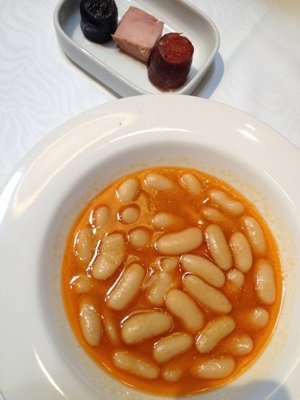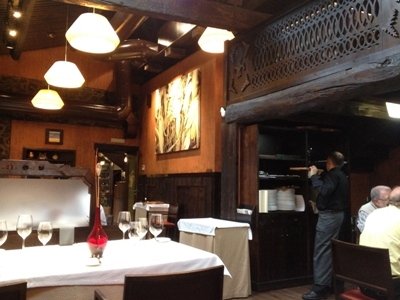Luxurious valleys, narrow canyons, impervious tops, woods that descend to the sea where the waves pour down on the irregular coast, sometimes steep but offering, here and there, small beaches of thin sand. The incredible landscape of Asturie, so little Spanish yet so fascinating, is the cover of a natural world that supplies excellent raw materials, from both sea and countryside. However – the same goes for Galicia and Cantabria, the two comunidades autónomas “sisters” – such an incredible, perhaps unique richness of gastronomic products has never produced any avantgarde cuisine, in comparison to that of Euskadi, the Basque region what is so similar from an environmental point of view; over here, good food is only a matter of tradition because it represents a simple occasion to share, and thus found (and still does) its acme in the meals based on Asturian fabada, a soup made with fabes, large white local beans with a thin skin and a buttery texture, in a tasty pork stock, paired with the three traditional local cuts: chorizo, morcilla and pancetta.

Morán's fabada, an interpretation of the great Asturian classic, made with the big white local beans in a pig meat broth, with chorizo, morcilla and bacon
Something, however, is changing. Asturian cuisine is giving some strong signs that it wants to enter the third millennium as two top representatives seem to be chasing the kitchen superstars according to the top-list created by the guru of Iberian critique, namely
Rafael García Santos, in
Lo Mejor de la Gastronomía. Both
Nacho Manzano of
Casa Marcial and
Marcos Morán of
Casa Gerardo deserve a very high mark, 9: as much as
Andoni Aduriz, that is to say, or as French chefs
Bras and
Ducasse, or again
Cracco and
Scabin.
Putting comparisons aside, our Asturian meals were transformed into as many extraordinary sensorial experiences: the chefs were at their best, at ease when using sublime raw materials – it’s impossible to find better
pescados y mariscos than in the secluded North-western Spain, but even the meat was perfect: lamb and piglets, mountain roosters... However, they have two different styles because they have had two different experiences.
Manzano is more mature, while 34-year-old
Marcos Morán seems to be still «a volcano full of lava that breathes fire into his creations». Product is his dogma; his useful brake is represented by his father, 60-year-old
Pedro Morán, the element of balance in this couple (
Marcos represents the fifth generation), and remind of other senior-junior pairs, such as
Vivalda,
Santini... It’s a dialogue of generations: «
Marcos wrestles with the devil inside him and the diplomatic wisdom of his father», writes
Santos.

Casa Gerardo, 75 euro for a tasting menu
The result, however, is well defined: their cuisine is vivid, basic, powerful, using a limited number of elements that have an almost ancestral feeling.
Pedro is very busy: the son holds in his hands the keys to his greatness and while he may sometimes exaggerate, and loose his balance, this is only because of an excessive personality. The tasting menu - which includes as the last savoury dish the famous
fabada: for very strong stomachs, at that point of the
comida – offers some notes of unquestionable excellence: the
Smoked sardine on beer and tomato foam is perfect; the
Cabeza del Pixin (monkfish with plankton cream in a fish and seaweed stock) is almost a iodic primordial soup; in the
Bacalao blanco y negro the fish is paired with creamy pil pil, black garlic, a plankton wafer and a milk foam and results in the signature dish of this duo as in the place, just like in the kitchen, the opposite elements (black and white, sweet and savoury, iodium and garlic…) find a perfect balance. After that, it’s the turn of the
Salmonete con coliflor picante, a mullet served with a spicy cauliflower cream and macadamia nuts, and you realise that
Marcos Morán is already knocking on the door of the stars’ Olympus.
1. to be continued